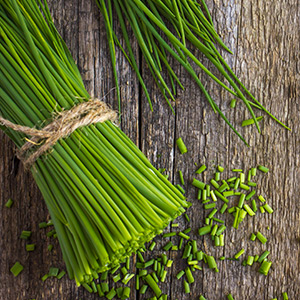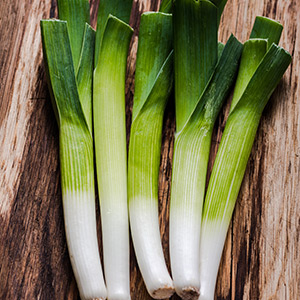- Strawberries
- Cook With Apples
- Grapes
- Grapefruit
- Lemons
- Cabbage
- Asparagus
- All About Bulb Vegetables
- All About Cruciferous Vegetables
- Squash
- All About Root Vegetables
- The Gift of Spice
- Thyme
- Basil
- Raspberries
- All About Tuber Vegetables
- Marjoram / Oregano
- Lemongrass / Citronella
- All Our Fruits, Vegetables and Fresh Herbs
- All About Exotic Fruits
- All About Legumes
- Cooking Pears: Three Inspirational Methods
All About Bulb Vegetables

Bulb vegetables, such as garlic, onion and leek, are aromatic vegetables that are used to flavour casseroles, broths, courts-bouillons and soups. They get their name because it’s not the leaves of the vegetables that are eaten, but the bulbs.
Some bulb vegetables are also known for their cancer- preventing and immune-boosting properties, as well as having other medicinal virtues. These wondrous vegetables not only turn simple dishes into flavourful meals, but can help improve health. Here are some popular varieties to enjoy more of.
Chives
Although it is considered an herb, chives are actually the smallest vegetable in the onion family. Chives have a very mild and delicate taste and aroma.
Characteristics
Whether in the wild or cultivated, chives grow very easily. The long, hollow green leaves are filiform and grow in clusters, reaching up to 20 centimetres in height. Each leaf stems from a bulb just below the ground and any uncut leaves will eventually bloom into small pink, white or purple flowers.
Culinary tips and advice
- Choose chives that are firm and dark green, free of any sign of mildew, mould or yellowing.
- To use, cut with a very sharp knife or snip with scissors directly over the dish.
- Chives are used to season a large number of hot and cold dishes and ideal for flavouring vinaigrettes, mayonnaise, softened butter or vegetable dips.
- In cooking, it is preferable to add chives at the last minute to preserve all of its flavour.
Availability
Chives are available year-round in the produce section.
Nutritional value
Chives are very low in calories and, like other allium species, have been linked to the prevention of certain cancers. They are also a good source of vitamins A and C.
Storage life
Chives will keep for a few days in the fridge and can be frozen without blanching.

Elephant garlic
Did you know that elephant garlic is not really garlic but rather a distant cousin of the leek? In fact, elephant garlic can be often referred to as summer leek, hard stem garlic, Oriental garlic, as well as horse garlic.

Characteristics
Elephant garlic is truly a giant! In ideal planting conditions, its bulb can grow to almost 500 grams. Each bulb is made of four to six cloves that are practically the size of a traditional garlic bulb, although there are smaller varieties of elephant garlic.
Its flavour is midway between leek and traditional garlic, though milder in taste than the latter. Elephant garlic is ideally eaten raw.
Culinary tips and advice
- Select plump, firm bulbs that are free of sprouts or stains and skin is intact.
- For easy peeling, crush garlic lightly with the flat side of a knife; the skin will come off almost by itself.
- Because of its subtle flavour, elephant garlic can complement any dish easily.
- Elephant garlic is an excellent choice for roasting in the oven due to its large size.
Availability
Elephant garlic is available year-round in the produce section.
Nutritional value
Elephant garlic is a source of manganese, phosphorus, iron, copper and vitamins B6 and C.
Storage life
Garlic should be stored in a dark, cool, airy and dry location, away from other foods.
Shallots
This slightly sweeter onion and has several different varieties and is integral to French cuisine.
Characteristics
The shallot is made of a cluster of two or three cloves, similar to garlic and much the same size. It is more fragrant and has a more subtle flavour than the onion. The skin of the shallot is orange-brown and the colour of its flesh varies from white to purple white.
Culinary tips and advice
- When purchasing, avoid shallots that are sprouting or soft.
- Shallots are often used to make condiments and can be found in classic sauces like béarnaise and red wine sauce.
- When browning shallots in butter or oil, be careful not to burn or scorch them because they will become bitter.
- Sliced and macerated in oil, shallots can be stored in the refrigerator for quite some time; the oil can be used to add flavour to any number of dishes.
Availability
Shallots are available year-round in the produce section.
Nutritional value
A good source of vitamins A and B6, shallots are known to lower cholesterol, blood pressure and help with digestion. Like other onions, they have anti-fungal and anti-bacterial — some even use it topically to soothe burns and insect bites!
Storage life
Shallots can be stored for up to one month in a dark, dry and cool area.

Leek
The leek has a subtle, refined taste that’s milder and sweeter than the onion.

Characteristics
The white part of the leek that grows under the earth is the most valued and often, the most consumed; only a small amount of it is needed to flavour dishes without masking the taste of other ingredients. The green leaves are ideal to use in soups, broths and simmered casseroles. The leek is harvested when the white part measures about ten centimetres.
Culinary tips and advice
- Choose firm leeks with nice green leaves and no brown spots or discolouration.
- Wash leeks carefully to remove any sand hidden between the leaves; cut the leaves lengthwise, leaving a few centimetres of the root intact, and rinse in a large bowl of water, spreading the leaves to clean thoroughly.
- Thinly sliced raw leeks make a nice addition to salads.
- Whole leeks can be served as a side dish; whether steamed, oven-baked or braised, cook just long enough for the leaves to soften — overcooking will leave them pasty and wilted.
- Thinly sliced leeks take about 20 minutes to soften at a low heat, 3 to 5 minutes to sautée on high heat and 10 minutes to simmer on medium-low heat.
Availability
Leeks are available year-round in the produce section.
Nutritional value
The leek is a good source of potassium, iron, vitamin C and B6, magnesium, copper and calcium. It is known to clear the digestive system.
Storage life
Leeks can be stored for two weeks in the refrigerator.
Onion
Cultivated for over 5,000 years, the onion is one of the oldest and most used vegetables in the world.
Characteristics
The dry onion is a vegetable composed of successive concentric layers of leaves. There are many different varieties of dry onions: yellow onions have a smooth sweet taste; white onions are mildest; and red onions are both mild and sweet. There are also small white onions and pearl onions, which can be white, brown or red. These are used to make marinades or cooked and served as a condiment or accompaniment.
Culinary tips and advice
- There are no limits to the use of onions — they can be added to tarts, soups, made into condiments or used raw!
- To weaken the bite of strong, raw onion, slice it and dip in boiling water for a few minutes, then quickly rinse under cold water to stop the cooking process.
Is it possible to cut an onion without crying?
Although the phenomenon differs depending on the variety of onion and the chef's sensitivity, here are few techniques that might help reduce watery eyes.
- Cut onion in two and dip in salted hot water
- Cut onions in water
- Stick a piece of bread at the end of your knife
- Use a serrated knife or bread knife to cut the onion
- Use a pizza cutter to cut the onion
- Hold a wooden match between your teeth with the incandescent end towards the cutting surface
- Cut the onion under the hood of your stove or near an open window
- Light a candle near the cutting surface
- Only breathe with your mouth while cutting the onion
- Chew gum while cutting the onion
- Place onion in freezer for ten minutes before cutting
Availability
Different varieties of onions are available year-round in the produce section.
Nutritional value
The onion contains potassium, vitamins C and B6 and folic acid. It’s a natural diuretic, stimulant and expectorant.
Storage life
The onion can be stored for up to two months in a cool, dark and dry area.

Spring onion
In Canada, spring onion can also be called scallions or green onion.

Characteristics
The spring onion is an aromatic plant that has been cultivated in China for over 2,000 years. The spring onion does not have a bulb but its base has more volume. The lower white part is fleshier than the chive and its long green narrow and hollow leaves can reach up to 50 centimetres. The spring onion has a slightly spicy taste, somewhere between the chive and dry onion.
Culinary tips and advice
- Choose firm, green spring onion stalks that show no sign of humidity or withering and have a pleasant aroma.
- Spring onions are used to season a multitude of hot and cold dishes, or to add flavour to vinaigrettes, mayonnaise, cream cheese and vegetable dips.
- The green leaves of the spring onion can be used like the chive, but in smaller quantities because the taste is stronger, while the white part can be used like dry onion.
- It is better to add chopped spring onion to dishes at the last minute to preserve its full flavour and aroma.
Availability
Spring onions are available year-round in the produce section.
Nutritional value
The spring onion is a good source of vitamins A and C, potassium, iron, folic acid, zinc and phosphorus.
Storage life
The spring onion can be stored for several days in the refrigerator and can easily be frozen without whitening.
Water chestnut
The water chestnut is a bulb vegetable that has thin brown skin and a crunchy, juicy, sweet and fragrant white flesh. It holds an important place in Asian cuisines.
Characteristics
The water chestnut grows in deep waters and, like rice, requires a lot of water to grow. This is why it is often cultivated in paddy fields. It has a delicate taste and a crunchy texture that makes it ideal in stir-fried and sautéed vegetable dishes, or served raw in salads. In North America, water chestnuts are mostly sold canned.
Culinary tips and advice
- Look for fresh water chestnuts that are very hard, without blemishes or soft parts
- Wash and peel in water
- Cooking chestnuts in fresh water will give them a slightly sweeter taste.
- Cook in water for 5 minutes or steam for 7 to 8 minutes
- The water chestnut adds a nice crunchy texture to sautées
Availability
Canned water chestnuts are available year-round.
Nutritional Value
The raw water chestnut is an excellent source of potassium, riboflavin, magnesium and phosphorus.
Storage life
Peeled water chestnuts can be stored for two to three days in the refrigerator. Unpeeled water chestnuts placed in a container of water can be stored for up to two weeks in the refrigerator. To freeze, first peel, wash and coat with lemon juice; they will keep for up to six months in the freezer.














